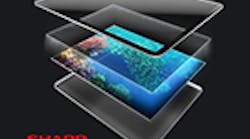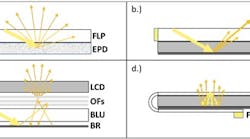Display technology is trying to move away from the backlight, and for good reason. In many devices the backlight is about as powerful as a car headlight, and most of the light it generates gets thrown away. Beyond any filtering or mixing, each pixel on an LCD has red, green and blue and only 5-10% of the backlight makes it through the pixels. That adds up to a lot more light wasted than used. This inefficiency was shrugged off for years. But device makers are starting to demand longer battery life, and the biggest draw of energy in our devices is the backlight.
Energy efficiency hasn’t always driven change. The wow factor is big for consumer electronics, but that’s starting to evolve as people come to rely more and more on their devices in their daily lives. And for medical and industrial safety devices, much more hangs in the balance. Time spent charging means time not spent monitoring.
OLEDs, MicroLEDs and other emissive displays are quickly gaining on LCDs in the consumer market. They’re more energy efficient than transmissive (backlit) displays and offer some dramatic quality improvements. Bringing the wow as well as the efficiencies. But there’s another type of display that’s even more efficient: Reflective, and this type of display has also seen many technological improvements in the past 5 years. As the name suggests, reflective displays reflect light (e.g., sunlight) to illuminate the pixels in a display. JDI and Sharp both manufacture reflective LCDs (or RLCDs) that can integrate a front light from FLEx Lighting. The front light is about as thin as a human hair and can bond to the top of a display using as few as one LED to create light. This allows Reflective displays to work even when there’s no ambient light. It’s an extremely efficient system that dramatically improves battery life.
Reflective displays also work well in direct sunlight, where transmissive (backlit) and emissive (e.g., OLED) struggle to perform. This is another benefit of Reflective displays, and it’s a significant one for devices that need to work outdoors. This is where IoT and wearables are pushing the boundaries of where our connected devices can go. Not only does a low power draw expand their reach, but sunlight readability makes them more effective in their environments.
Another benefit of RLCDs is the fact that they work from a mature and robust LCD technology. For device makers, this makes them easier to integrate and source. The time may have come to move that backlight up to the front where it will demand less and not fight the sources of light around it.

